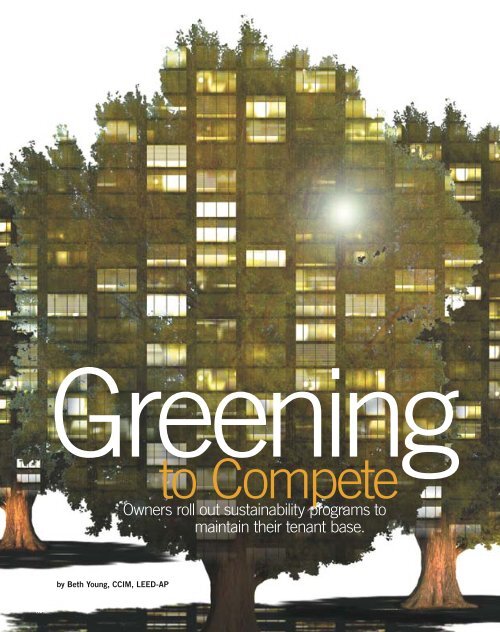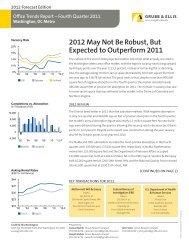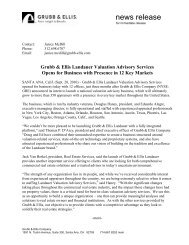attracting tenants and achieving - Grubb & Ellis
attracting tenants and achieving - Grubb & Ellis
attracting tenants and achieving - Grubb & Ellis
You also want an ePaper? Increase the reach of your titles
YUMPU automatically turns print PDFs into web optimized ePapers that Google loves.
Greening<br />
to Compete<br />
Owners roll out sustainability programs to<br />
maintain their tenant base.<br />
by Beth Young, CCIM, LEED-AP<br />
32 March |A<br />
April | 2010<br />
Commercial mer<br />
lI<br />
Investment ent Real Estate<br />
Et<br />
te
firm in Houston, has offices in a non-green building currently; however,<br />
he will only consider LEED-certified buildings for his next<br />
lease. Fortunately he will have a number of choices: At year-end<br />
2009, Houston had 60 LEED-certified buildings <strong>and</strong> 600 additional<br />
buildings that are LEED registered. L<strong>and</strong>lords are quickly realizing<br />
that besides being environmentally minded, they must make energysaving<br />
improvements simply to compete for <strong>tenants</strong> — especially in<br />
a down market.<br />
Sealing the Envelope<br />
What retrofitting measures offer the most return on the investment<br />
when either selling the building or <strong>attracting</strong> <strong>tenants</strong> <strong>and</strong> <strong>achieving</strong><br />
higher rental <strong>and</strong> occupancy rates?<br />
Energy savings is the obvious place to start. Te larger wastes are in<br />
lighting, heating, ventilation, <strong>and</strong> air conditioning systems, <strong>and</strong> the<br />
thermal envelope of the building. More than 70 percent of existing<br />
buildings have not upgraded lighting, HVAC, insulation, or windows,<br />
according to engineering research reports. Yet a 2006 U.S. Green<br />
Building Council survey found that building owners save 90 cents psf<br />
annually by retrofitting their properties, <strong>and</strong> earn back their investment<br />
in two to 2.5 years.<br />
Check the Database of State Incentives for Renewables<br />
<strong>and</strong> Efficiency (www.dsireusa.org) to find out what<br />
tax credits, grants, financialincen tives, <strong>and</strong><br />
other energy efficiency funding your state offers.<br />
Are sustainability <strong>and</strong> energy efficiency<br />
upgrades playing a role in today’s down<br />
commercial real estate market? Definitely,<br />
say those in the field.<br />
“I recently lost a 20,000-square-foot<br />
office tenant to a Silver LEED [Leadership<br />
in Energy <strong>and</strong> Environmental<br />
Design] certified building that was<br />
$2.12 more per square foot than our<br />
building,” says Doug Webster, an office<br />
leasing specialist with <strong>Grubb</strong> & <strong>Ellis</strong>/<br />
Te Furman Co. in Greenville, S.C.<br />
“Te tenant’s broker said they preferred<br />
our location, layout, <strong>and</strong><br />
lower rate, but the fact that the<br />
[building] owners were not<br />
willing to institute a formal<br />
sustainability program caused<br />
this national engineering firm<br />
to select the LEED location.<br />
Subsequently, we are now working<br />
with the owners to put a rolling<br />
sustainability program in place as <strong>tenants</strong><br />
vacate or update their space.”<br />
Researchers working with CoStar<br />
Group have studied the green trend<br />
<strong>and</strong> the findings support this example.<br />
Since 2005, the nationwide difference<br />
in occupancy rates between Energy<br />
Star buildings <strong>and</strong> their peers has grown<br />
from almost zero to approximately 2.5 percent<br />
in 2009. Te occupancy rate difference is 5.4<br />
percent when LEED-certified buildings are compared<br />
to non-certified buildings.<br />
National rental rate differences for Energy Star buildings<br />
vs. their peers have increased from $2.32 psf in 2005 to<br />
$4.73 psf in 2009. If only LEED-certified buildings are compared<br />
to non-certified buildings, the rental rate gulf is $9.06 psf. Tese are<br />
serious incentives for l<strong>and</strong>lords to upgrade their office buildings.<br />
David Brewer, president of Brewer & Escalante, an engineering<br />
ciremagazine.com<br />
az<br />
ine co<br />
Before making any changes, find out where <strong>and</strong> how much energy<br />
is currently being used. Many utility companies will do a free or inexpensive<br />
energy audit to discover a building’s unique energy deficiencies<br />
<strong>and</strong> potential for improvement, says Timothy Buckley, LEED-<br />
AP, an architect with Greenstone Architecture in Vancouver, Wash.<br />
“Based on the energy audit findings, you can then assess upgrade<br />
needs, estimate first costs <strong>and</strong> returns on the investments, <strong>and</strong> begin<br />
establishing priorities for upgrades,” Buckley says.<br />
Building envelopes can provide quick savings when renovated.<br />
Upgrading insulation can be a low-cost improvement with a fast<br />
return. Weather stripping <strong>and</strong> weather sealing, for example, quickly<br />
improves the building’s defenses. A more costly change that has a big<br />
impact on savings is the replacement of old windows <strong>and</strong> doors with<br />
new high-performance versions.<br />
In 2009, the General Services Administration Workplace Performance<br />
Study concluded that if only 40 percent of GSA-owned buildings<br />
were retrofitted with properly sealed high-performance R4 windows<br />
with high visible transmission (60 percent or greater) to maximize<br />
daylight, the estimated annual energy savings would be $12.8 million.<br />
March | April | 2010<br />
SMILEUS/Veer; Jon Le-Bon/Veer<br />
33
34<br />
THE FUTURE: ACHIEVING<br />
NET-ZERO ENERGY<br />
Net-zero energy buildings are super energy-efficient, grid-connected buildings that<br />
use on-site generation systems, such as solar power <strong>and</strong> geothermal energy, to produce<br />
as much energy as they consume. The U.S. Department of Energy, through<br />
its Net-Zero Energy Commercial Building Initiative, aims to achieve marketable<br />
commercial net-zero energy buildings by 2025 <strong>and</strong> is working closely with industry<br />
leaders through the Commercial Building Energy Alliances to make it happen.<br />
Commercial Building Energy Alliances are informal associations of building<br />
owners <strong>and</strong> operators who evaluate, test, <strong>and</strong> ultimately implement replicable<br />
approaches to creating a variety of energy-effi cient buildings in several different<br />
climate zones. To date, DOE has created three alliances to represent specifi c<br />
sectors: the Retailer Energy Alliance, the Commercial Real Estate Energy Alliance,<br />
<strong>and</strong> the Hospital Energy Alliance.<br />
Alliance members work with DOE <strong>and</strong> national laboratories to compare <strong>and</strong><br />
contrast emerging technologies in real-life scenarios. Eventually, other commercial<br />
building owners <strong>and</strong> operators will use alliance members’ experience <strong>and</strong><br />
research to purchase energy-effi cient technologies with a better idea of their<br />
potential return on investment.<br />
Through a t<strong>and</strong>em program, the Commercial Building Partnerships, more than<br />
20 companies <strong>and</strong> organizations will conduct research <strong>and</strong> development to construct<br />
new buildings that use 50 percent less energy <strong>and</strong> retrofit buildings that use<br />
30 percent less energy. The teams will then share results with alliance members.<br />
As of October 2009, 44 companies, representing 23 percent of the market share,<br />
belonged to the Commercial Real Estate Energy Alliance, <strong>and</strong> the Retailer Energy Alliance’s<br />
membership includes 39 companies representing more than 17 percent of the<br />
market share. Alliance members include Re/Max Real Estate, Transwestern, USAA<br />
Real Estate Co., <strong>and</strong> Walmart. For more information on the Net-Zero Energy Commercial<br />
Building Initiative, visit www.commercialbuildings.energy.gov.<br />
—by Dru Crawley, who leads the U.S. Department of Energy’s Net-Zero Energy Commercial<br />
Building Initiative. For more information about the Commercial Building Energy<br />
Alliances, visit www.buildings.energy.gov/alliances.<br />
COMMERCIAL BUILDINGS’ ENERGY CONSUMPTION<br />
Computers, 156 trillion Btu 1%<br />
2%<br />
Cooking, 190 trillion Btu<br />
Refrigeration<br />
381 trillion Btu<br />
Ventilation<br />
436 trillion Btu<br />
Water heating<br />
501 trillion Btu<br />
Office equipment<br />
69 million Btu<br />
3%<br />
6%<br />
7%<br />
8%<br />
Cooling<br />
516 trillion Btu<br />
Source: Energy Information Administration<br />
Other<br />
569 trillion Btu<br />
9%<br />
8% 21%<br />
36%<br />
Space heating<br />
2,365 trillion Btu<br />
Lighting, 1,340 trillion Btu<br />
Total consumption<br />
6,523 trillion Btu<br />
Upgrading windows also will contribute to<br />
human comfort <strong>and</strong> performance by reducing<br />
drafs <strong>and</strong> noise <strong>and</strong> improving end-user<br />
access to daylight <strong>and</strong> views. Te greater efficiency<br />
will pay for the cost difference in three<br />
to five years, the study reported.<br />
Lighting the Way<br />
Lighting system upgrades range from<br />
simple changes to a complete replacement.<br />
Easy changes include reducing excessive or<br />
unneeded lighting. For example, on a small<br />
scale, one lamp can be removed from existing<br />
three-tube fluorescent systems, <strong>and</strong> for<br />
larger areas, occupancy sensors <strong>and</strong> time<br />
clocks can automatically reduce hours of<br />
lighting. A Portl<strong>and</strong>, Ore., building owner<br />
replaced the 24-hour, seven-days-a-week<br />
fluorescent lighting in a four-acre parking<br />
garage with motion-activated lights that<br />
dim by 90 percent when no one is around.<br />
Te same approach can be used in interior<br />
restrooms, storage areas, hallways, <strong>and</strong><br />
other infrequently used common areas.<br />
“If considering a wholesale lighting replacement,<br />
look at reducing lighting power budgets<br />
<strong>and</strong> using high-efficiency low-mercury<br />
fluorescent systems, or even LED,” Buckley<br />
says. “Te initial cost of LED technology is<br />
still pretty steep; however, the energy savings<br />
over time are significant — up to 70<br />
percent, according to some universities that<br />
have made the switch. And it may make it<br />
worthwhile when considering LED’s incredibly<br />
long life. Te reduced maintenance <strong>and</strong><br />
costs savings associated with not having to<br />
re-lamp other systems can be a huge factor.”<br />
Deregulated purchasing of electricity at<br />
lower rates is another area for great cost savings.<br />
<strong>Grubb</strong> & <strong>Ellis</strong> manages facilities-related<br />
purchasing for United Stationers at 80 locations<br />
across the U.S. It purchased electricity<br />
at lower rates in deregulated states for a savings<br />
of $865,000.<br />
Te owner of New York’s Sony Building<br />
also chose <strong>Grubb</strong> & <strong>Ellis</strong> to manage the building,<br />
including reducing energy <strong>and</strong> operating<br />
expenses. Solutions included making<br />
recommendations for electricity purchasing<br />
<strong>and</strong> including the Sony Building in a pooled<br />
bid. G&E also reduced peak rate charges by<br />
reviewing electrical charges <strong>and</strong> time-of-day<br />
usage records to determine spike usage. Afer<br />
March | April | 2010 Commercial Investment Real Estate
isolating the cause <strong>and</strong> changing procedures, G&E reduced the building’s<br />
electrical costs by $1 million per year. A lighting retrofit resulted<br />
in additional energy savings <strong>and</strong> a local tax rebate of $400,000.<br />
In another example, a national financial-services company implemented<br />
numerous initiatives in the operation of the building’s HVAC<br />
equipment, reduced interior lighting, added more lighting controls,<br />
<strong>and</strong> installed carbon dioxide <strong>and</strong> motion sensors to increase efficiency<br />
<strong>and</strong> reduce waste. Teir sustainability efforts yielded an annual estimated<br />
energy savings of 11 percent.<br />
In Portl<strong>and</strong>, the 17-story Liberty Centre office building received a<br />
BOMA award in 2007 for its superior energy efficiency. As much as<br />
30 percent of the building’s energy is renewable <strong>and</strong> it has seen energy<br />
savings of more than $40,000 a year.<br />
On a smaller scale, a creative way to reduce operating expenses is to<br />
go from a gross or full-service lease including electricity to a net lease<br />
with separate metering of electricity for each tenant. Studies show<br />
that <strong>tenants</strong> receiving individual utility bills consume an average of<br />
21 percent less electricity.<br />
Turning Off the Water<br />
Water reduction is another area of significant savings. One of the<br />
most beneficial changes can be in the retrofit of a building’s interior<br />
water fixtures. For example, efficient water faucets <strong>and</strong> toilets<br />
provided a 67 percent return on investment in as little as 1.5 years<br />
for 200 Market Street in Portl<strong>and</strong>, Ore. “Te 19-story building<br />
achieved a 31 percent water-use reduction beyond the Uniform<br />
Plumbing Code by retrofitting their plumbing fixtures,” says Elaine<br />
Aye of Green Building Services, who managed the building’s LEED<br />
certification process.<br />
Once changes have been made, it’s important to make sure they<br />
continue working as designed. “A continuous monitoring system<br />
can be installed to diligently monitor [the building’s] energy use <strong>and</strong><br />
also allow for system adjustments,” says Eric Haskins, a G&E vice<br />
president in Portl<strong>and</strong>. “Te engineers are notified by automated text<br />
message whenever building systems stray from their set parameters.<br />
Tis process ensures that the building’s operational systems can be<br />
preemptively maintained.”<br />
Tenants <strong>and</strong> investors clearly are recognizing the value associated<br />
with sustainable upgrades, whether it affects the bottom line or<br />
improves their image with clients. With savings <strong>and</strong> returns like the<br />
examples given here, a more appropriate question might be, How can<br />
a l<strong>and</strong>lord afford not to make green upgrades?<br />
Beth Young, CCIM, LEED-AP, is vice president of <strong>Grubb</strong> & <strong>Ellis</strong> Co.’s<br />
Investment Services Group in Houston. Contact her at beth.young@<br />
grubb-ellis.com.<br />
DO GREEN BUILDINGS MAKE<br />
DOLLARS AND SENSE?<br />
The University of San Diego’s Burnham-Moores Center for Real Estate is working to uncover the financial impact of sustainability on<br />
real estate markets. A well-cited 2008 paper by USD Professor Norm Miller <strong>and</strong> Jay Spivey <strong>and</strong> Andy Florance of CoStar found that<br />
green U.S. office buildings — defined as either LEED or Energy Star-certified — enjoy higher occupancy rates, higher rents, <strong>and</strong><br />
lower operating expenses, when compared with non-green buildings with similar characteristics. [See main article.]<br />
The results also show higher sales prices by nearly 15 percent more per square foot. This is an encouraging sign for those investing<br />
in energy savings, particularly considering that the estimated cost of <strong>achieving</strong>, for example, LEED ED Silver status, is modest, ing from 0 percent to 5 percent in additional building costs.<br />
rang-<br />
More recently, Burnham-Moores researchers teamed up with CB Richard <strong>Ellis</strong> to measure the productivity of <strong>tenants</strong> in green<br />
buildings. Property managers <strong>and</strong> <strong>tenants</strong> in 154 green buildings managed by CBRE nationwide participated in an online survey,<br />
which used two measures of productivity: self-reports <strong>and</strong> number of sick days. More than half of the respondents said their<br />
employees have been more productive since moving into the green space. Forty-five percent of <strong>tenants</strong> nts surveyed enced fewer employee sick days, with another 45 percent experiencing no change.<br />
experi-<br />
Researchers also explored the marketplace barriers that exist to building green. USD Professors Louis Galuppo<br />
<strong>and</strong> Charles Tu surveyed real estate capital market participants to assess their perceptions regarding the costs,<br />
benefits, <strong>and</strong> risks of green buildings. The overwhelming majority of the respondents believed that an energyefficient<br />
building has higher value than a comparable traditional building, although they also thought green<br />
buildings cost more to construct. When asked if they believed green buildings generate a net benefit, nearly<br />
60 percent said yes, slightly more than 20 percent said no, <strong>and</strong> about 20 percent were not sure. The results<br />
indicate that many capital providers are still skeptical about the economics of building green.<br />
—by Norm Miller, vice president of analytics at the CoStar Group <strong>and</strong> a distinguished research professor at<br />
the University of San Diego’s Burnham-Moores Center for Real Estate. Contact him at nmiller@s<strong>and</strong>iego.edu.<br />
Charles Tu, CFA, LEED-AP, is an associate professor <strong>and</strong> Jeryldine Saville is the communications director at the<br />
Burnham-Moores Center for Real Estate. Contact them at ctu@s<strong>and</strong>iego.edu <strong>and</strong> jsaville@s<strong>and</strong>iego.edu.<br />
ciremagazine.com<br />
March | April | 2010<br />
35











